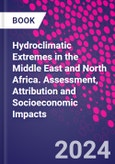Hydroclimatic Extremes in the Middle East and North Africa: Assessment, Attribution and Socioeconomic Impacts focuses on assessing the current situation of hydroclimatic extremes in the MENA region, with particular emphasis on dry and wet extreme events. The results of the rapidly changing atmospheric and oceanic situations of these extremes is addressed, presenting examples for the environmental, socioeconomic and cultural impacts of these events in the region and evaluating the current ability to monitor and adapt to such events. In addition, the book explores the potential use of advanced geospatial techniques in improving current understanding of these extreme events.The book utilizes a multidisciplinary approach with various state-of-the-art methods, approaches, and analytical techniques in environmental, meteorological, and hydrological sciences, providing case studies from the Middle East and North Africa region. It will be a valuable source of information for climatologists, meteorologists, hydrologists, agronomists, geographers, and water resource scientists.
Table of Contents
Part 1: Hydrological and climatological perspectives of the Middle East and North Africa1. Hydrological regimes in the Middle East and North Africa: characteristics and challenges
2. Changes in the Climate Zones of the Middle East and North Africa under future climate change scenarios
3. Hydroclimatic extremes in the Middle East and North Africa: status and challenges
4. Water stress and insecurity in the Middle East and North Africa under different environmental and socioeconomic stressors
5. Monitoring and analysing hydroclimatic extremes using GIS and Remote Sensing techniques: case studies from the Sahara deserts
Part II: Hydroclimatic extremes in the Middle East and North Africa: Past, present and future
6. Rainfall Characteristics in Egypt during the second half of the 20th century: patterns, variability and impacts
7. Changes in rainfall concentration over Syria from 1960 to 2015
8. Long-term interannual to decadal variability of Libya extended-winter drought in Libya
9. Characterization of hydrological drought over Algeria in the past four decades
10. Attributing drought characteristics in Iraq to large-scale circulation patterns
11. Large boulders deposited on the north-western coast of Egypt as an Indicator of extreme sea waves
12. Threatened landscapes of Cyrenaica: adverse climate change impacts vs. anthropogenic processes
Part III: Socioeconomic and political impacts of the intensification of hydroclimatic extremes in the Middle East and North Africa
13. The links between meteorological and hydrological droughts in the main hydrological regimes over the Middle East and North Africa and their possible impacts on food production
14. Impacts of present and future intensification of heat waves on energy demand in Southwestern Asia
15. The potentials of the usage of renewable energy in the Middle East and North Africa under climate change conditions
16. Analysis of urban heat island using night-time MODIS LST data as a signal for regional climate change: A case study in the United Arab Emirates
17. Monitoring urbanization growth and its impacts on climatic changes over Greater Cairo (Egypt) using satellite images
18. Hydrological insecurity in the Middle East and North Africa in view of international disputes: the case of the Ethiopian Renaissance Dam
19. Climate change and it impacts on selected archaeological sites in Egypt
Part IV: Adaptation and resilience to climate extremes
20. Urban planning in the Middle East and North Africa in view of climate justice: selected case studies
21. Adaptation and resilience to sea level rise impacts in Oman
22. Improving climate services in the Middle East region in a changing climate
23. Future projections of Hydroclimate extremes: lessons for adaptation in the Middle East and North Africa








